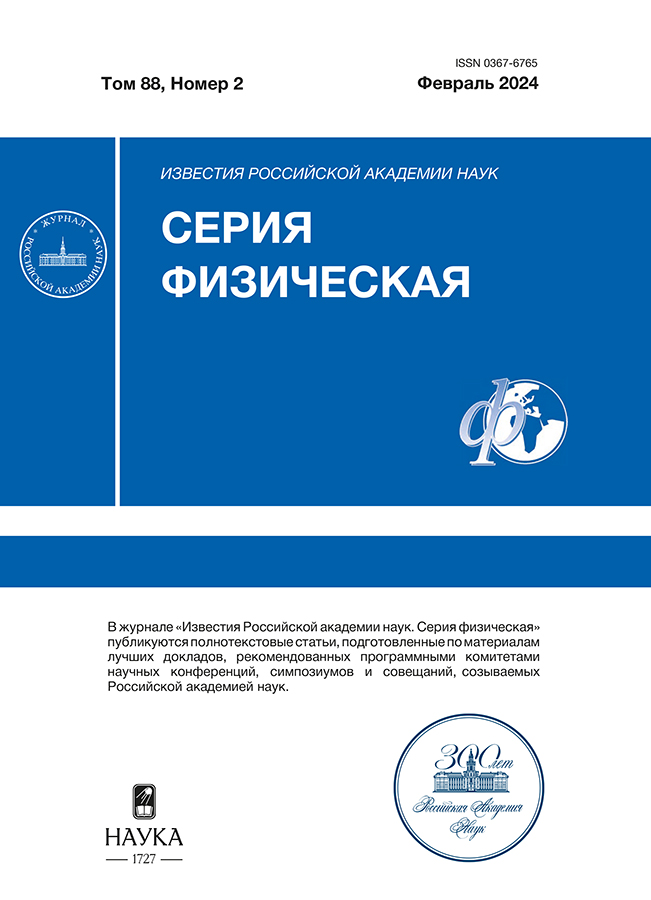Efficiency of sub-THz – DC energy conversion of a silicon detector
- 作者: Shchepetilnikov A.V.1, Khisameeva A.R.1, Fedotova Y.V.1, Dryomin A.A.1, Kukushkin I.V.1
-
隶属关系:
- Osipyan Institute of Solid-State Physics of the Russian Academy of Sciences
- 期: 卷 88, 编号 2 (2024)
- 页面: 180-184
- 栏目: New Materials and Technologies for Security Systems
- URL: https://cardiosomatics.ru/0367-6765/article/view/654746
- DOI: https://doi.org/10.31857/S0367676524020025
- EDN: https://elibrary.ru/RTWKBX
- ID: 654746
如何引用文章
详细
The efficiency of sub-THz to DC energy conversion of a silicon-based plasmonic detector was studied. The dependence of the signal at the detector output on the incident radiation power was measured. In the power linear region, the coefficient η was shown to grow with increasing power and to saturate in the sub-linear regime. The maximum achieved values of η were 0.4% for the radiation frequency of 97 GHz. The measurements were carried out both at room temperature and when the detector was cooled to liquid nitrogen temperature.
全文:
作者简介
A. Shchepetilnikov
Osipyan Institute of Solid-State Physics of the Russian Academy of Sciences
编辑信件的主要联系方式.
Email: shchepetilnikov@issp.ac.ru
俄罗斯联邦, Chernogolovka
A. Khisameeva
Osipyan Institute of Solid-State Physics of the Russian Academy of Sciences
Email: shchepetilnikov@issp.ac.ru
俄罗斯联邦, Chernogolovka
Ya. Fedotova
Osipyan Institute of Solid-State Physics of the Russian Academy of Sciences
Email: shchepetilnikov@issp.ac.ru
俄罗斯联邦, Chernogolovka
A. Dryomin
Osipyan Institute of Solid-State Physics of the Russian Academy of Sciences
Email: shchepetilnikov@issp.ac.ru
俄罗斯联邦, Chernogolovka
I. Kukushkin
Osipyan Institute of Solid-State Physics of the Russian Academy of Sciences
Email: shchepetilnikov@issp.ac.ru
俄罗斯联邦, Chernogolovka
参考
- Baydin A., Makihara T., Peraca N.M., Kono J. // Front. Optoelectron. 2021. V. 14. P. 110.
- Wang P.L., Lou J., Fang G.Y., Chang C. // IEEE Trans. Microw. Theory Techn. 2022. V. 70. No. 11. P. 5117.
- Pearson J.C., Drouin B.J., Yu S. // IEEE J. Microw. 2021. V. 1. No. 1. P. 43.
- Chen Z., Ma X., Zhang B. et al. // China Commun. 2019. V. 16. No. 2. P. 1.
- Yang X., Zhao X., Yang K. et al. // Trends Biotechnol. 2016. V. 34. No. 10. P. 810.
- Tzydynzhapov G., Gusikhin P., Muravev V. et al. // J. Infrared Millim. Terahertz Waves. 2020. V. 41. No. 6. P. 632.
- Shchepetilnikov A.V., Gusikhin P.A., Muravev V.M. et al. // Appl. Opt. 2021. V. 60. No. 33. P. 10448.
- Shinohara N. Recent wireless power transfer technologies via radio waves. Gistrup: River Publishers, 2018.
- Mizojiri S., Shimamura K. // IEEE Asia-Pacific Microwave Conference (APMC). (Singapore, 2019). P. 705.
- Citroni R., Di Paolo F., Livreri P. // Nanomaterials. 2022. V. 12. No. 14. P. 2479.
- Joseph S.D., Hsu Sh.H.S., Huang Y. // IEEE Int. Symp. Radio-Freq. Integr. Technol. (RFIT). 2021. P. 1.
- Muravev V.M., Gusikhin P.A., Andreev I.V., Kukushkin I.V. // Phys. Rev. Lett. 2015. V. 114. No. 10. Art. No. 106805.
- Muravev V.M., Gusikhin P.A., Zarezin A.M. et al. // Phys. Rev. B. 2019. V. 99. No. 24. Art. No. 241406.
- Muravev V.M., Kukushkin I.V. // Appl. Phys. Lett. 2012. V. 100. No. 8. Art. No. 082102.
- Муравьев В.М., Соловьев В.В., Фортунатов А.А. и др. // Письма в ЖЭТФ. 2016. Т. 103. № 12. С. 891.
- Shchepetilnikov A.V., Kaysin V.D., Gusikhin P.A. et al. // Opt. Quantum Electron. 2019. V. 51. No. 12. P. 1.
- Shchepetilnikov A.V., Kukushkin I.V., Muravev V.M. et al. // J. Infrared Millim. Terahertz Waves. 2020. V. 41. No. 6. P. 655.
- Хисамеева А.Р., Щепетильников А.И., Федотова Я.В. и др. // Изв. РАН. Сер. физ. 2023. Т. 87. № 2. С. 172; Khisameeva A.R., Shchepetilnikov A.V., Fedotova Ya.V. et al. // Bull. Russ. Acad. Sci. Phys. 2023. V. 87. No. 2. P. 145.
- Chiou H.K., Chen I.S. // IEEE Trans. Microw. Theory Techn. 2010. V. 58. No. 12. P. 3598.
- Weissman N., Jameson S., Socher E. W-band CMOS on-chip energy harvester and rectenna // IEEE MTT-S Int. Microwave Symp. (Tampa, 2014). P. 1.
- Kapilevich B., Shashkin V., Litvak B. et al. // IEEE Microwave. Wirel. Compon. Lett. 2016. V. 26. No. 8. P. 637.
- Shaulov E., Jameson S., Socher E. // IEEE MTT-S Int. Microwave Symp. (Honolulu, 2017). P. 307.
- He P., Zhao D.A. // IEEE MTT-S Int. Microwave. Symp. (Boston, 2019). P. 634.
- Wentzel A., Yacoub H., Johansen T.K. et al. // Proc. 17th EuMIC (Milan, 2022). P. 208.
补充文件










